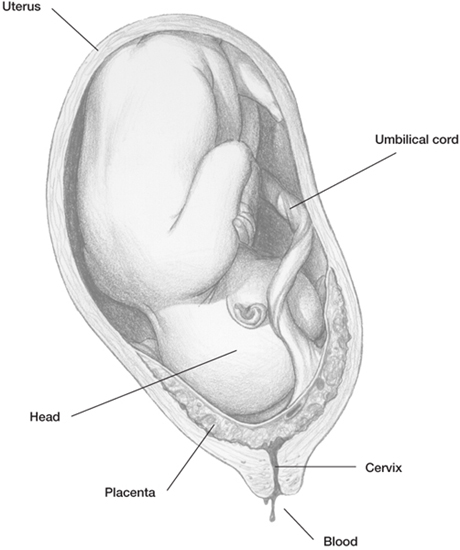What Is Placenta Previa?
With placenta previa, the
placenta attaches to the lower part of the uterus instead of the upper
wall; it lies close to the cervix or covers it. The problem occurs
about once in every 170 pregnancies.
Placenta previa is serious because of the
chance of heavy bleeding. Bleeding may occur during pregnancy or during
labor. There are three main types of placenta previa:
• placenta touches the cervix (low-lying placenta)
• the placenta partially covers the cervix (partial placenta previa)
• the placenta completely covers the cervix (total placenta previa)
The cause of placenta previa is not
completely understood. Risk factors include previous Cesarean delivery,
over age 30, smoking and delivery of several babies.

In this illustration of total placenta previa, note how the placenta
completely covers the cervical opening to the uterus.
A woman who
conceives with in-vitro fertilization has a greater chance of
developing placenta previa. Experts believe insertion of the embryo
into the uterus may cause contractions, which could cause the embryo to
implant low in the uterus, raising the risk of placenta previa. In
addition, embryos may intentionally be implanted low in the uterus
because research shows this placement may improve the chance of
pregnancy.
The most characteristic symptom of
placenta previa is painless bleeding without contractions. This doesn’t
usually occur until close to the end of your second trimester or later
when the cervix thins out, stretches and tears the placenta loose.
Bleeding may occur without warning and
may be extremely heavy. It occurs when the cervix begins to dilate with
early labor, and blood escapes.
Placenta previa should be considered when
a woman has vaginal bleeding during the second half of pregnancy. The
problem can’t be diagnosed with a physical exam because a pelvic
examination may cause heavier bleeding. Healthcare providers use
ultrasound to identify the problem. Ultrasound is particularly accurate
in the second half of pregnancy because the uterus and placenta are
bigger, and things are easier to see.
Your healthcare provider may advise you
not to have a pelvic exam if you have placenta previa. This is
important to remember if you see another healthcare provider or when
you go to the hospital.
It’s not possible to deliver the placenta
first, followed by the baby. The baby may also be in a breech
presentation. Babies are usually delivered by Cesarean delivery. The
baby is delivered first, then the placenta is delivered so the uterus
can contract. Bleeding can be kept to a minimum.
Some Information May Scare You
If a woman experiences a serious
problem, she and her partner will probably want to know as much about
it as possible. If a woman has a friend or knows someone who has
problems during pregnancy, reading about it might relieve her fears. We
also hope our discussions can help you start a dialogue with your
doctor, if you have questions.
Nearly all pregnancies are uneventful,
and serious situations don’t arise. However, please know we have tried
to cover as many aspects of pregnancy as we possibly can so you’ll have
all the information at hand that you might need and want. Knowledge is
power, so having various facts available can help you feel more in
control of your own pregnancy. We hope reading it helps you relax and
have a great pregnancy experience.
If you find serious discussions frighten
you, don’t read them! Or if the information doesn’t apply to your
pregnancy, just skip over it. But realize information is there if you
want to know more about a particular situation.
8. Exercise for Week 35
Stand with your feet apart, knees softly
bent. Raise your arms so your upper arms are parallel to the floor and
your hands point up into the air. Squeeze your shoulder blades
together, hold for 3 seconds, then release. Do 10 times. Improves posture and relieves upper-back stress.
